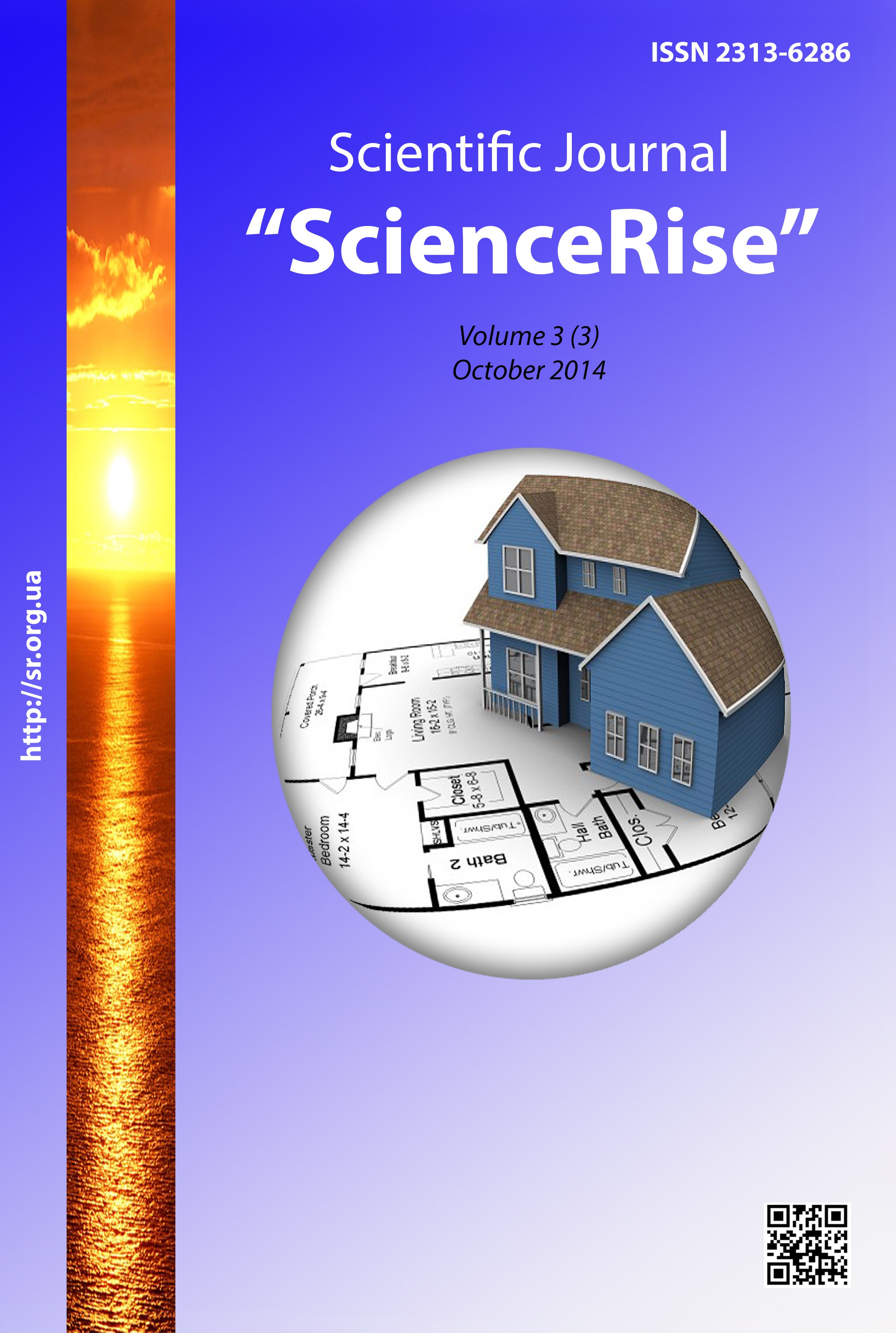Динаміка антоціанів в процесі старіння квітів Ipomea Purpurea опромінених УФ-В радіацією
DOI:
https://doi.org/10.15587/2313-8416.2014.27621Ключевые слова:
антоціани, УФ-В опромінення, монокарпічні рослини, динаміка старінняАннотация
Досліджено динаміку зменшення вмісту антоціанів у процесі старіння пелюсток Ipomoea purpurea, яка характеризує швидкість деградаційних процесів у клітині. Проаналізовано вплив різних доз УФ-В-опромінення на швидкість вікової деградації антоціанів. Показано, що в межах дослідженого діапазону, УФ-опромінення тільки одна доза - 12,6 кДж/м2 сприяла уповільненню темпів розпаду антоціанів. Обговорено вірогідні механізми, що пов`язують старіння і деградацію пігментів.
Библиографические ссылки
1. Dubrov, A. P. (1968). Geneticheskie i fiziologicheskie jeffekty dejstvija ul'trafioletovoj radiacii na vysshie rastenija. Moscow: Nauka, 249.
2. Isachenko, M. S., Ivashhenko, N. I. (2009). Issledovanie antocianov jagodnogo syr'ja. Kachestvennoe i kolichestvennoe opredelenie. Pishhevaja promyshlennost': Nauka i tehnologii, 3 (1), 80–83.
3. Mullagulov, R. T., Timerbulatova, G. R. (2012). Kolichestvennoe soderzhanie antocianov v lekarstvennom rastitel'nom syr'e. Privolzhskij nauchnyj vestnik, 6 (2), 3–5.
4. Tanchev, S. S. (1980). Antociany v plodah i ovoshhah. Moscow: Pishhevaja promyshlennost', 304.
5. Mazza, G. (1993). Anthocyanins in fruits, vegetables and grains. Boca Raton: CRC Press Inc, 362.
6. Chalker-Scott, L. (2002). Do anthocyanins function as osmoregulators in leaf tissues? Advances in Botanical Research, 37, 103–127. http://dx.doi.org/10.1016/s0065-2296(02)37046-0
7. Jaakola, L. (2004). Activation of flavonoid biosynthesis by solar radiation in bilberry (Vaccinium myrtillus L.) leaves. Planta, 218 (5), 721–728. http://dx.doi.org/10.1007/s00425-003-1161-x
8. Steyn, W. J. (2002). Anthocyanins in vegetative tissues: a proposed unified function in photoprotection. New Phytologist, 155 (8), 349–361. http://dx.doi.org/10.1046/j.1469-8137.2002.00482.x
9. Stapleton, A. E. (1994). Flavonoids can protect maize DNA from the induction of ultraviolet radiation damage. Plant Physiology, 105 (3), 881–889. http://dx.doi.org/10.1104/pp.105.3.881
10. Harvaux, M. (2001). The protective functions of carotenoid and flavonoid pigments against excess visible radiation at chilling temperature investigated in Arabidopsis npq and tt mutants. Planta, 213 (6), 953–966. http://dx.doi.org/10.1007/s004250100572
11. Chupahina, G. N., Maslennikov, P. V. (2004). Adaptacija rastenij k neftjanomu stressu. Jekologija, 5, 330–335.
12. Gould, K. S. (2002). Do anthocyanins function as antioxidants in leaves? Imaging of H2O2 in red and green leaves after mechanical injury. Plant, Cell and Environment, 25 (10), 1261–1269. http://dx.doi.org/10.1046/j.1365-3040.2002.00905.x
13. Field, T. S., Lee, D. W., Holbrook, N. M. (2001). Why leaves turn red in autumn. The role of anthocyanins in senescing leaves of red-osier Dogwood. Plant Physiology, 127 (2), 566–574. http://dx.doi.org/10.1104/pp.010063
14. Hoch, W. A. (2003). Resorption protection. Anthocyanins facilitate nutrient recovery in autumn by shielding leaves from potentially damaging light levels. Plant Physiology, 133 (3), 1296–1305. http://dx.doi.org/10.1104/pp.103.027631
15. Grodzinskij, D. M., Gushha, N. I., Perkovskaja, G. Ju. (2002). Vlijanie hronicheskogo obluchenija na adaptivnyj potencial rastenij. Radiobiologija rastenij, 42 (2), 155–158.
16. Lange, H., Shropshire, W., Mohr, H. (1971). An analysis of phytochrome mediated anthocyanin synthesis. Plant Physiol, 47 (5), 649–655. http://dx.doi.org/10.1104/pp.47.5.649
17. Yamada, T., Ichimura, K., Kanekatsu, M. (2007). Gene expression in opening and senescing petals of morning glory (Ipomoea nil) flowers. Plant Cell Rep, 26, 823–835. http://dx.doi.org/10.1007/s00299-006-0285-4
18. Kong, J. M. (2003). Analysis and biological activities of anthocyanins. Phytochemistry, 64 (5), 923–933. http://dx.doi.org/10.1016/s0031-9422(03)00438-2
19. Harborne, J. B. (2001). Аnthocyanins and other flavonoids. Natural Product Reports, 18, 310–333.Загрузки
Опубликован
Выпуск
Раздел
Лицензия
Copyright (c) 2014 Анастасія Миколаївна Берестяна

Это произведение доступно по лицензии Creative Commons «Attribution» («Атрибуция») 4.0 Всемирная.
Наше издание использует положения об авторских правах Creative Commons CC BY для журналов открытого доступа.
Авторы, которые публикуются в этом журнале, соглашаются со следующими условиями:
1. Авторы оставляют за собой право на авторство своей работы и передают журналу право первой публикации этой работы на условиях лицензии Creative Commons CC BY, которая позволяет другим лицам свободно распространять опубликованную работу с обязательной ссылкой на авторов оригинальной работы и первую публикацию работы в этом журнале.
2. Авторы имеют право заключать самостоятельные дополнительные соглашения, которые касаются неэксклюзивного распространения работы в том виде, в котором она была опубликована этим журналом (например, размещать работу в электронном хранилище учреждения или публиковать в составе монографии), при условии сохранения ссылки на первую публикацию работы в этом журнале .

